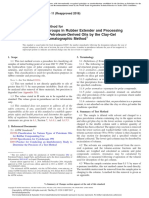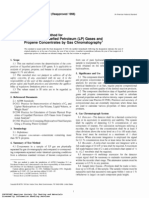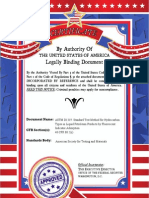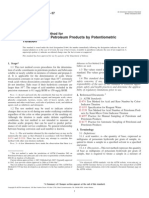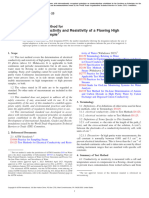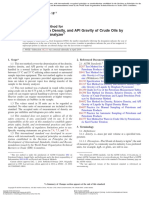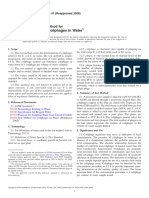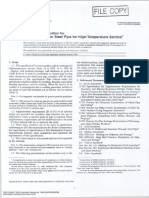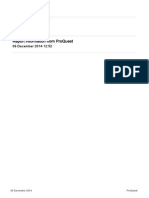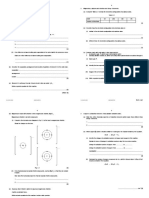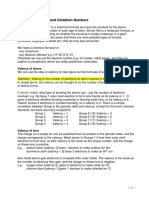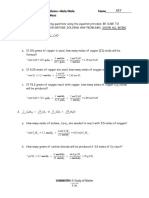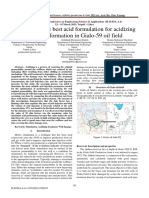Astm D4412-02 BSR
Astm D4412-02 BSR
Uploaded by
Jose Luis LopezCopyright:
Available Formats
Astm D4412-02 BSR
Astm D4412-02 BSR
Uploaded by
Jose Luis LopezOriginal Title
Copyright
Available Formats
Share this document
Did you find this document useful?
Is this content inappropriate?
Copyright:
Available Formats
Astm D4412-02 BSR
Astm D4412-02 BSR
Uploaded by
Jose Luis LopezCopyright:
Available Formats
Designation: D 4412 – 84 (Reapproved 2002)
Standard Test Methods for
Sulfate-Reducing Bacteria in Water and Water-Formed
Deposits1
This standard is issued under the fixed designation D 4412; the number immediately following the designation indicates the year of
original adoption or, in the case of revision, the year of last revision. A number in parentheses indicates the year of last reapproval. A
superscript epsilon (e) indicates an editorial change since the last revision or reapproval.
1. Scope water, Fifteenth Edition3
1.1 These test methods cover the procedure for the detection 3. Terminology
and enumeration by the most probable number (MPN) tech-
nique of sulfate-reducing bacteria in water or water-formed 3.1 Definitions—For definitions of terms used in these test
deposits. methods, refer to Terminology D 1129.
1.2 Two media preparations are provided. Medium A which 3.2 Definitions of Terms Specific to This Standard: —For a
is prepared with reagent grade water, and Medium B which is description of the term MPN used in these test methods, refer
prepared using the water to be sampled as the water source. to literature.4
Medium B is offered for those special conditions where 4. Summary of Test Methods
sulfate-reducing bacterial strains have adapted to atypical
non-fresh water environment. 4.1 Water and water deposit samples and dilutions of these
1.3 For the isolation and enumeration of thermophilic samples are dispensed into tubes of Starkey’s medium (A or B)
sulfate-reducing bacteria encountered in waters associated with following five tube MPN procedures. The tubes are sealed with
oil and gas production, all broths, dilution blanks, and incuba- liquid paraffin, and incubated at 20°C for 21 days.4 Positive
tions must be maintained at temperatures of at least 45°C and reactions are indicated by the deposit of a black precipitate.
preferably within 5°C at the sample temperature. 5. Significance and Use
1.4 The sensitivity of these test methods can be increased by
purging the dilution blanks and tubes of media with nitrogen 5.1 Sulfate-reducing bacteria are widely distributed in ma-
immediately prior to use. rine and fresh water muds which, in consequence, frequently
1.5 The analyst should be aware that adequate collaborative are laden with the hydrogen sulfide produced by these organ-
data for precision and bias statements as required by Practice isms during dissimilatory sulfate reduction.
D 2777 are not provided. See Section 11 for details. 5.2 It has been reported that Desulfovibrio can form as
1.6 This standard does not purport to address all of the much as 10 g of sulfide per litre during active multiplication.
--````,`,`,````,,```,,`,,,`,,``-`-`,,`,,`,`,,`---
safety concerns, if any, associated with its use. It is the Sulfate-reducing bacteria can cause the external or internal
responsibility of the user of this standard to establish appro- corrosion of water or wastewater pipelines and pipelines for
priate safety and health practices and determine the applica- petroleum and natural gas. The formation of galvanic cells by
bility of regulatory limitations prior to use. massive growth of sulfate-reducing bacteria under suitable
conditions makes the corrosion much worse than just the effect
2. Referenced Documents of the hydrogen sulfide on the metal or concrete.
2.1 ASTM Standards: 6. Apparatus and Materials
D 1129 Terminology Relating to Water2
D 1193 Specification for Reagent Water2 6.1 Anaerobic Incubator, 20°C, if available, or conventional
D 2777 Practice for Determination of Precision and Bias of 20°C incubator.5
Applicable Methods of Committee D19 on Water2 6.2 Pipets, sterile, 1 mL and 10 mL,“ calibrated” to deliver.
D 3370 Practices for Sampling Water from Closed Con- 6.3 Test Tubes, with close fitting or airtight caps; 16 by 150
duits2 mm and 20 by 150 mm.
2.2 APHA Standard: 6.4 Test Tube Racks, of sufficient size to contain 16 and
Standard Methods for the Examination of Water and Waste- 20-mm tubes.
1 3
These test methods are under the jurisdiction of ASTM Committee D19 on Available from American Public Health Association, 1015 18th St. N.W.,
Water and are the direct responsibility of Subcommittee D19.24 on Water Micro- Washington, DC 20036.
4
biology. Bonde, G. J., “Bacterial Indicators of Water Pollution,” A Study of Quantitative
Current edition approved Oct. 26, 1984. Published February 1985. Estimation, Teknisk Forlag, Copenhagen, 1963.
2 5
Annual Book of ASTM Standards, Vol 11.01. For thermophilic organisms use a 45°C incubator.
Copyright © ASTM International, 100 Barr Harbor Drive, PO Box C700, West Conshohocken, PA 19428-2959, United States.
Copyright ASTM International 1
Reproduced by IHS under license with ASTM Licensee=Occidental Chemical Corp New sub account/5910419101
No reproduction or networking permitted without license from IHS Not for Resale, 10/21/2005 16:09:59 MDT
D 4412 – 84 (2002)
7. Reagents p-Aminodimethylaniline dihydrochloride 1.0 g
(C8H12N2·2HCl)
7.1 Purity of Reagents—Reagent grade chemicals shall be HCl (6 N) 500 mL
used in all tests. Unless otherwise indicated, it is intended that
all reagents conform to the specifications of the Committee on Dissolve 1 g of p-aminodimethylaniline dihydrochloride in
Analytical Reagents of the American Chemical Society,6 when 500 mL of 6 N HCl. Store for up to 1 month in an amber
such specifications are available. airtight container.
7.6 Liquid Paraffın—Heavy, sterile, or sterile mineral oil.
7.2 Purity of Water—Unless otherwise indicated, references
7.7 Buffered Dilution Water—Stock Solution
to water shall be understood to mean Reagent Water Type II
7.7.1 Dissolve 34.0 g of KH2PO4 in 500 mL of water, adjust
conforming to Specification D 1193. In addition, reagent water
pH to 7.2 with 1 N NaOH and dilute to 1 L with distilled water.
used for these test methods must be sterile.
This is called the stock phosphate solution.
7.3 Starkey’s Medium A—7 (modified): 7.7.2 Dissolve 38 g of MgCL2 in 1 L of distilled water.
Sodium lactate (C3H5NaO3) 3.5 g 7.8 Buffered Dilution Water, Working Solution—Add 1.25
Ammonium chloride (NH4Cl) 1.0 g
Dipotassium, hydrogen orthophosphate 0.5 g mL of stock buffered dilution water and 5 mL of MgCl2
(K2HPO4) solution to 500 mL of water. Bring to 1 L with water. Mix well
Magnesium sulfate (MgSO4·7H2O) 2.0 g and dispense as 90 mL dilution blanks in screw-capped bottles.
Sodium sulfate (Na2SO4) 0.5 g
Calcium chloride (CaCl2·2H2O) 0.1 g Sterilize by autoclaving at 121°C for 15 min.
Thioglycollic acid 0.1 g
Ammonium ferrous sulfate or ferrous 0.001g 8. Procedure
ammonium sulfate
((NH4)2SO4·FeSO4·6H2O) 8.1 Clean and disinfect the area with a cleaning solution that
Water (H2O) 1 L leaves no residue.
7.3.1 Double strength medium (23) is prepared as above 8.2 Set out and label five replicate tubes of 10-mL double-
except 500 mL of water are used instead of 1 L. strength Starkey’s medium, A or B, in the test tube rack.
8.3 Set out and label five replicate tubes of 10-mL single-
7.3.2 Heat to dissolve and dispense 9 mL of medium per
strength Starkey’s medium, A or B, for each mL of sample or
single strength tube, and 10 mL per double strength tube.
mL of sample dilution to be tested. Use two sets of five
7.3.3 Tubes should be of sufficient capacity to contain 1 mL replicate 10-mL tubes, each to contain 1 mL of sample or 1 mL
of inoculum plus 9 mL of single strength medium or 10 mL of of 1/10 dilution of sample.
inoculum plus 10 mL of 23 medium. 8.4 Prior to sample inoculation, heat tubes of media and
7.3.4 pH of medium should be 7.2 after autoclave steriliza- dilution blanks in a water bath to 60°C then cool rapidly to
--````,`,`,````,,```,,`,,,`,,``-`-`,,`,,`,`,,`---
tion, at 121°C for 15 min. 20°C to ensure minimal oxygen levels.
7.4 Starkey’s Medium B—The medium is similar to that 8.5 Shake sample thoroughly,8 at least 25 times; make
described in 7.3, 7.3.1, and 7.3.2 with the following modifica- dilutions starting with 10 mL of sample into one 90-mL
tion: dilution blank.
7.4.1 Water collected from the sample collection site is used 8.6 Pipet 10 mL of sample into each double-strength broth
to prepare the medium outlined in 7.3. The water sample is and 1 mL of sample or diluted sample into each set of five
filtered to remove particulates (1.2 µm membrane filter) and the single-strength broths.
pH is recorded. 8.7 Maintain anaerobic conditions by layering 2 to 3 ml of
7.4.1.1 After preparing the Medium B following 7.3.1, sterile liquid paraffin in each tube.
7.3.2, and 7.3.3, and prior to dispensing, check and adjust pH, 8.8 Recap tubes and incubate at 20°C for 21 days.
if necessary to that of the original water used, then filter 8.9 Include sterile water samples with each test as negative
sterilize the medium by passage through 0.2-µm filter and controls.
asceptically dispense into presterilized tubes. 8.10 Positive reaction is indicated by the deposit of a black
7.5 Hydrogen Sulfide Test Reagent: precipitate (sulfide).
7.5.1 Ferric Chloride Stock Solution (FeCl3·6H2O)— 8.11 Confirm dubious results by the addition of 0.5 mL of
Dissolve 13.5 g of ferric chloride in a mixture of 250 mL of ferric chloride reagent followed by 0.5 mL of
water and 250 mL of HCl (sp gr 1.19). Store in an airtight p-aminodimethylaniline reagent to the MPN tube. Add reagent
amber container. Prepare fresh monthly. to the bottom of the tube using syringe or long Pasteur pipet. A
positive reaction, blue color, occurs within 10 min if H2S is
7.5.2 p-Aminodimethylaniline Dihydrochloride Stock Solu-
present.
tion
9. Calculation
9.1 Compute the number of positive findings resulting from
6
“Reagent Chemicals, American Chemical Society Specifications,” American multiple-portion decimal dilution planting as the combination
Chemical Society, Washington, DC. For suggestions on the testing of reagents not of positives and recorded in terms of the Most Probable
listed by the American Chemical Society, see “Reagent Chemicals and Standards,” Number3 (MPN).
by Joseph Rosin, D. Van Nostrand Co., Inc., New York, NY, and the “United States
Pharmacopeia.”
7
Starkey, R. L., “Characteristics and Cultivation of Sulfate-Reducing Bacteria,”
8
Journal of the American Water Works Association, Vol 40, 1948, pp. 1291–1298. Organisms do not appear to be hypersensitive to small amounts of oxygen.
Copyright ASTM International 2
Reproduced by IHS under license with ASTM Licensee=Occidental Chemical Corp New sub account/5910419101
No reproduction or networking permitted without license from IHS Not for Resale, 10/21/2005 16:09:59 MDT
D 4412 – 84 (2002)
9.2 When more than three series of tubes are employed in a testing can not be carried out. Statements can only be made on
decimal series of dilutions, use the results from only three of the precision of the MPN procedure.
these used in computing the MPN, for example: 11.2 Unless a large number of portions of sample are
10 1 0.1 0.01 examined, the precision of the MPN is rather low. For example,
mL mL mL mL
5/5 5/5 2/5 0/5 = 5-2-0 3 10 = 490/100 mL even when the sample contains one organism per millilitre,
5/5 4/5 2/5 0/5 = 5-4-2 = 220/100 mL about 37 % of tubes inoculated with 1 mL of sample may be
5/5 3/5 1/5 1/5 = 5-3-2 = 140/100 mL
5/5 0/5 0/5 0/5 = 5-0-0 = 23/100 mL
expected to yield negative results because of irregular distri-
bution of the bacteria in the sample and the multiple attachment
10. Report of bacteria to particles. When five tubes, each with 1 mL of
10.1 Report the results as number of sulfate-reducing bac- sample, are employed under these conditions, a completely
teria per 100 mL of sample. negative result may be expected less than 1 % of the time.
Thus, even when five tubes are employed for each dilution, the
11. Precision and Bias 9
precision of the results obtained is not of a high order.
11.1 Due to the instability of the organisms, round robin
11.3 See the Research Report for results of a single labora-
tory, two operator study.
9
Supporting data for these test methods have been filed at ASTM Headquarters.
Request RR: D-19-1116.
ASTM International takes no position respecting the validity of any patent rights asserted in connection with any item mentioned
in this standard. Users of this standard are expressly advised that determination of the validity of any such patent rights, and the risk
of infringement of such rights, are entirely their own responsibility.
This standard is subject to revision at any time by the responsible technical committee and must be reviewed every five years and
if not revised, either reapproved or withdrawn. Your comments are invited either for revision of this standard or for additional standards
and should be addressed to ASTM International Headquarters. Your comments will receive careful consideration at a meeting of the
responsible technical committee, which you may attend. If you feel that your comments have not received a fair hearing you should
make your views known to the ASTM Committee on Standards, at the address shown below.
This standard is copyrighted by ASTM International, 100 Barr Harbor Drive, PO Box C700, West Conshohocken, PA 19428-2959,
United States. Individual reprints (single or multiple copies) of this standard may be obtained by contacting ASTM at the above
address or at 610-832-9585 (phone), 610-832-9555 (fax), or service@astm.org (e-mail); or through the ASTM website
(www.astm.org).
--````,`,`,````,,```,,`,,,`,,``-`-`,,`,,`,`,,`---
Copyright ASTM International 3
Reproduced by IHS under license with ASTM Licensee=Occidental Chemical Corp New sub account/5910419101
No reproduction or networking permitted without license from IHS Not for Resale, 10/21/2005 16:09:59 MDT
You might also like
- ASTM D4052-2022 Densidad Digital Productos Del PetróleoDocument9 pagesASTM D4052-2022 Densidad Digital Productos Del Petróleodmvaldes21No ratings yet
- Filterable and Nonfilterable Matter in Water: Standard Test Method ForDocument7 pagesFilterable and Nonfilterable Matter in Water: Standard Test Method ForRashaZakaria100% (2)
- Astm D6560-17Document6 pagesAstm D6560-17Angel MurilloNo ratings yet
- PH of Water: Standard Test Methods ForDocument10 pagesPH of Water: Standard Test Methods ForSaravanan NatesanNo ratings yet
- D5002 Densidad Por Densimetro Digital PDFDocument5 pagesD5002 Densidad Por Densimetro Digital PDFkarfer78No ratings yet
- Astm Astm d2887 PDFDocument20 pagesAstm Astm d2887 PDFharNo ratings yet
- ASTM D4006 Agua Por DestilacionDocument11 pagesASTM D4006 Agua Por DestilacionEnder IbañezNo ratings yet
- ASTM - Volume 08 - Part 01 - D1824 - Downloaded - 2011-05-21Document3 pagesASTM - Volume 08 - Part 01 - D1824 - Downloaded - 2011-05-21nerissaloveNo ratings yet
- Norma Astm d2007-11 (Reapproved 2016)Document8 pagesNorma Astm d2007-11 (Reapproved 2016)CamiloAndresGuerrero0% (1)
- TNRCC Method 1005 Determinación de Hidrocarburos de Pretoleo PresentesDocument26 pagesTNRCC Method 1005 Determinación de Hidrocarburos de Pretoleo PresentesSusana DiazNo ratings yet
- Astm D888-18 Oxigeno DisueltoDocument14 pagesAstm D888-18 Oxigeno DisueltoAlvaro Pérez Pérez100% (4)
- ASTM D1218-12-Reapproved-2016Document7 pagesASTM D1218-12-Reapproved-2016djalovicNo ratings yet
- ASTM D1067 Acidez o Alcalinidad de AguaDocument8 pagesASTM D1067 Acidez o Alcalinidad de AguafamturboNo ratings yet
- Kinematic Viscosity of Asphalts (Bitumens) : Standard Test Method ForDocument10 pagesKinematic Viscosity of Asphalts (Bitumens) : Standard Test Method ForMUDI SOBARHADINo ratings yet
- Astm d1126 - 1 (En)Document4 pagesAstm d1126 - 1 (En)m daneshpourNo ratings yet
- ASTM D6166-97 (Color Gardner)Document3 pagesASTM D6166-97 (Color Gardner)Kevin Lora VillarrealNo ratings yet
- Astm d4052Document8 pagesAstm d4052Muhannad NasifNo ratings yet
- Astm d2624Document8 pagesAstm d2624Victor fajardo100% (1)
- Ash From Petroleum Products: Standard Test Method ForDocument4 pagesAsh From Petroleum Products: Standard Test Method ForNelson GomesNo ratings yet
- ASTM D2669-06 Apparent Viscosity of Petroleum Waxes Compounded PDFDocument5 pagesASTM D2669-06 Apparent Viscosity of Petroleum Waxes Compounded PDFLluís FontNo ratings yet
- Particulate Contamination in Aviation Fuels by Laboratory FiltrationDocument11 pagesParticulate Contamination in Aviation Fuels by Laboratory FiltrationMuhammad KhairuddinNo ratings yet
- ASTM D1298 12bDocument6 pagesASTM D1298 12bRedha Iktibar HidayatNo ratings yet
- ASTM D2163 GLP CromatografiaDocument5 pagesASTM D2163 GLP Cromatografiaalejandrogrande100% (1)
- Astm d1319 2003 PDFDocument10 pagesAstm d1319 2003 PDFJeffreyCheleNo ratings yet
- ASTM D 524 Residuo Carbonoso PDFDocument8 pagesASTM D 524 Residuo Carbonoso PDFMaria BradaNo ratings yet
- D5452 Contaminantes ParticuladosDocument11 pagesD5452 Contaminantes ParticuladosMaria SoutoNo ratings yet
- ASTM D 5454 11 Humedad Con AnalizadorDocument3 pagesASTM D 5454 11 Humedad Con AnalizadorCarlos Lopez BlumenkronNo ratings yet
- Astm D4468Document5 pagesAstm D4468Anonymous xERghLP8V100% (2)
- ASTM D1945-14 Análisis de Gas Por CromatDocument17 pagesASTM D1945-14 Análisis de Gas Por CromatAngel MurilloNo ratings yet
- Astm D2386Document5 pagesAstm D2386sawitri diah ayu komalaNo ratings yet
- Astm D 664 - 07Document8 pagesAstm D 664 - 07Alfonso MartínezNo ratings yet
- ASTM D3921 Grasas y Aceites en AguaDocument7 pagesASTM D3921 Grasas y Aceites en AguafamturboNo ratings yet
- E516Document10 pagesE516aahtagoNo ratings yet
- ASTM D3227 - Jtvo9242Document6 pagesASTM D3227 - Jtvo9242Nayth Andres GalazNo ratings yet
- Astm D5391 - 23Document8 pagesAstm D5391 - 23Bay NguyenNo ratings yet
- D5462 PDFDocument6 pagesD5462 PDFZamir Danilo Morera ForeroNo ratings yet
- ASTM D5002-18e1Document6 pagesASTM D5002-18e1Angel MurilloNo ratings yet
- ASTM D1126 Durezas en AguaDocument4 pagesASTM D1126 Durezas en AguafamturboNo ratings yet
- Water Using Volumetric Karl Fischer Titration: Standard Test Method ForDocument10 pagesWater Using Volumetric Karl Fischer Titration: Standard Test Method ForJorge RamirezNo ratings yet
- Chloride Ion in Water: Standard Test Methods ForDocument9 pagesChloride Ion in Water: Standard Test Methods ForSaravanan Natesan100% (2)
- Down FileDocument12 pagesDown FileSalma FarooqNo ratings yet
- Titulacion Petroleum IndustryDocument96 pagesTitulacion Petroleum Industryluis hernandezNo ratings yet
- Astm - 4006Document11 pagesAstm - 4006CarlosJayaNo ratings yet
- ASTM D5854-19aDocument22 pagesASTM D5854-19amohammedyilmaz1985No ratings yet
- Astm D1160 - 18Document20 pagesAstm D1160 - 18Metrologia Piedecuesta Solumed Ingenieria Ltda100% (2)
- D1159Document9 pagesD1159rpajaro75No ratings yet
- (Thiol Mercaptan) Sulfur in Gasoline, Kerosine, Aviation Turbine, and Distillate Fuels (Potentiometric Method)Document8 pages(Thiol Mercaptan) Sulfur in Gasoline, Kerosine, Aviation Turbine, and Distillate Fuels (Potentiometric Method)Dennise ChicaizaNo ratings yet
- ASTM D1142 - 95 (R2012) - Water Vapor Content of Gaseous Fuels by Measurement of Dew-Point TemperatureDocument11 pagesASTM D1142 - 95 (R2012) - Water Vapor Content of Gaseous Fuels by Measurement of Dew-Point TemperaturegisegiseNo ratings yet
- Norma ASTM G140Document2 pagesNorma ASTM G140Jaqueline Gutierrez RobledoNo ratings yet
- Determination of Trace Elements in Middle Distillate Fuels by Inductively Coupled Plasma Atomic Emission Spectrometry (ICP-AES)Document11 pagesDetermination of Trace Elements in Middle Distillate Fuels by Inductively Coupled Plasma Atomic Emission Spectrometry (ICP-AES)Nguyen Hoang QuanNo ratings yet
- UOP Method 46-85 Ceras de ParafinaDocument6 pagesUOP Method 46-85 Ceras de ParafinaAngel MurilloNo ratings yet
- D7884 13Document5 pagesD7884 13Dewi WulandhariNo ratings yet
- PH of Soils: Standard Test Method ForDocument3 pagesPH of Soils: Standard Test Method ForMelissa Vega Reynoso100% (1)
- D 4328 97 PDFDocument6 pagesD 4328 97 PDFMohamed ElfawalNo ratings yet
- D 511 - 03 - Rduxmq - PDFDocument9 pagesD 511 - 03 - Rduxmq - PDFacunajulio100% (1)
- D 2331 - 80 R99 - RdizmzetodbsotkDocument5 pagesD 2331 - 80 R99 - Rdizmzetodbsotkdelta lab sangliNo ratings yet
- Método de Prueba Standar para Materia Filtranble y No Filtrable en Agua D5907Document7 pagesMétodo de Prueba Standar para Materia Filtranble y No Filtrable en Agua D5907Edson Roberto Olivares CeliNo ratings yet
- Low Levels of Coliphages in Water: Standard Test Method ForDocument6 pagesLow Levels of Coliphages in Water: Standard Test Method ForProvocateur SamaraNo ratings yet
- Calcium and Magnesium in Water: Standard Test Methods ForDocument6 pagesCalcium and Magnesium in Water: Standard Test Methods Fort.mohammedNo ratings yet
- Calcium and Magnesium in Water: Standard Test Methods ForDocument9 pagesCalcium and Magnesium in Water: Standard Test Methods ForasmybablooNo ratings yet
- Fra801G Thru Fra807G: 8.0 AMPS. Glass Passivated Fast Recovery RectifiersDocument2 pagesFra801G Thru Fra807G: 8.0 AMPS. Glass Passivated Fast Recovery RectifiersJose Luis LopezNo ratings yet
- Astm A106 PDFDocument13 pagesAstm A106 PDFJose Luis LopezNo ratings yet
- Astm D3359-02Document8 pagesAstm D3359-02Jose Luis Lopez100% (1)
- Schaltplan GP 320 Interlock Panel +ISDocument74 pagesSchaltplan GP 320 Interlock Panel +ISJose Luis Lopez100% (1)
- Crude ProquestDocument11 pagesCrude ProquestMiguelNo ratings yet
- 8ch0 01 Que 20230517 PDFDocument28 pages8ch0 01 Que 20230517 PDFDharshaan GopaulNo ratings yet
- New Technologies For HCL Regeneration in Chloride HydrometallurgyDocument11 pagesNew Technologies For HCL Regeneration in Chloride HydrometallurgyEmiliano Rodriguez TellezNo ratings yet
- Mgcl2 Lab Report: Percentage PurityDocument4 pagesMgcl2 Lab Report: Percentage PurityDianaNo ratings yet
- Practice KEY - Stoichiometry PAP 2019-2020-4Document16 pagesPractice KEY - Stoichiometry PAP 2019-2020-4toxxic21No ratings yet
- Paper 4 DoubleDocument6 pagesPaper 4 Doublebob bobNo ratings yet
- Advanced Subsidiary Gce Chemistry: Foundation Chemistry Morning Time: 1 HourDocument12 pagesAdvanced Subsidiary Gce Chemistry: Foundation Chemistry Morning Time: 1 HourEusha FawadNo ratings yet
- ASTM G36-94 (Reapproved 2013)Document7 pagesASTM G36-94 (Reapproved 2013)shuli liNo ratings yet
- Exampro GCSE Chemistry C2 PDFDocument18 pagesExampro GCSE Chemistry C2 PDFProject InfoNo ratings yet
- GCSE Chemistry Reaction of Acids. AQA OCR Edexcel. QuestionsDocument3 pagesGCSE Chemistry Reaction of Acids. AQA OCR Edexcel. Questionsjennifer lohNo ratings yet
- MSDS Magnesium Chloride Hexahydrate FlakesDocument6 pagesMSDS Magnesium Chloride Hexahydrate FlakesRodrigo Ramos100% (1)
- VJC Prelim 2009 H2 Chemistry 9746/2 Suggested Answers: Correct Bond AngleDocument15 pagesVJC Prelim 2009 H2 Chemistry 9746/2 Suggested Answers: Correct Bond AngleVinson OngNo ratings yet
- 08-09 Practice 2nd Trimester ExamDocument9 pages08-09 Practice 2nd Trimester ExamEmily LeeNo ratings yet
- Formulae and Oxidation NumbersDocument14 pagesFormulae and Oxidation NumbersDoc_CrocNo ratings yet
- Day-95-Unit 8 Mixed Problems Mole-Mole and Mole-Mass SolutionsDocument2 pagesDay-95-Unit 8 Mixed Problems Mole-Mole and Mole-Mass SolutionsmuzuribwanaNo ratings yet
- 1 s2.0 S0167577X10002430 MainDocument3 pages1 s2.0 S0167577X10002430 Mainwb9269xkzkNo ratings yet
- November 2022 (v1) QPDocument16 pagesNovember 2022 (v1) QPsafiyya husnaNo ratings yet
- SEAFDEC Practicum ReportDocument23 pagesSEAFDEC Practicum ReportSam BrilloNo ratings yet
- CHY1701 M1 - Dr. Krishnendu BiswasDocument52 pagesCHY1701 M1 - Dr. Krishnendu Biswaslalithkumaran LNo ratings yet
- ASTM D3230-13 (Reaprobada 2018) Salinidad en CrudoDocument7 pagesASTM D3230-13 (Reaprobada 2018) Salinidad en CrudoAngel MurilloNo ratings yet
- Magnesium Alloys: Raw Material ProductionDocument25 pagesMagnesium Alloys: Raw Material Productionmohamad hafizNo ratings yet
- Lab Report Exp 1 (CHM432)Document12 pagesLab Report Exp 1 (CHM432)pufff witchesNo ratings yet
- 3.2 Group IIDocument9 pages3.2 Group IITrần Duy ThịnhNo ratings yet
- Science 2&3 SymbolsDocument11 pagesScience 2&3 SymbolsThadicherlaHrishithNo ratings yet
- Third Written Test in Science 10 QUARTER 4, SY 2021-2022Document5 pagesThird Written Test in Science 10 QUARTER 4, SY 2021-2022joan marie PeliasNo ratings yet
- Astm e 449 Cloruro de CalcioDocument5 pagesAstm e 449 Cloruro de Calcioandrea sanchezNo ratings yet
- AcidizingDocument7 pagesAcidizingKhawla ArtimeNo ratings yet
- 110 WS Solution Stoichiometry KeyDocument2 pages110 WS Solution Stoichiometry KeyAMORES, JOHANNA MIKAELANo ratings yet
- Bab 3 Persamaan Kimia - Soalan ObjektifDocument4 pagesBab 3 Persamaan Kimia - Soalan ObjektifBiLL adhamNo ratings yet
- Production of Magnesium From Great Salt Lake Utah USADocument8 pagesProduction of Magnesium From Great Salt Lake Utah USAraminNo ratings yet








